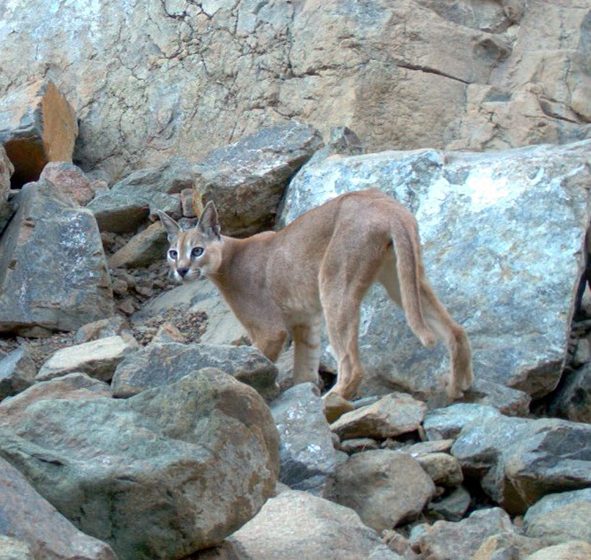In a First for the Region, 5 UAE Companies Recruit 13+ Students from Indian B-School Masters’ Union
World Habitat Day.. Arabian Caracal rediscovered in UAE’s Wadi Wurayah National Park

Rare wild cat species – listed as critically endangered in the UAE – caught on camera, highlighting the importance of monitoring key species and protecting the habitats they rely on.
Caracal sighting builds on the successful long-standing conservation efforts of the Fujairah Environment Authority, Emirates Nature-WWF and Mashreq.
Public invited to join biodiversity surveys and help maintain motion-sensor cameras as ‘citizen scientists’ through the Notice Nature wildlife mapping initiative.
Wadi Wurayah, Fujairah, 6 October 2025
In a milestone for conservation, the Arabian caracal (Caracal caracal schmitzi) has been rediscovered in Wadi Wurayah National Park, the UAE’s first mountain protected area, managed by the Fujairah Environment Authority (FEA). The species, listed as Critically Endangered on the UAE National Red List, was captured on motion-sensor cameras through the Notice Nature wildlife mapping initiative powered by Mashreq and implemented in partnership with FEA and environmental charity Emirates Nature-WWF.
This latest rediscovery follows previous sightings, after years without confirmed records, the species was documented again on Jebel Hafeet in 2019, near Wadi Shees in March 2023, and now in Wadi Wurayah in 2025, offering fresh hope for its survival. Each sighting provides critical data to assess the species’ status, inform protection of its fragile habitats and guide conservation strategies. It shows that a locally or regionally threatened species still persists, validating conservation efforts, the effectiveness of Protected Areas and prompting targeted protection measures to prevent extinction.

The Arabian caracal is one of the most iconic predators in the region, instantly recognisable by its striking black ear tufts and powerful build, and for its role as an apex predator keeping mountain ecosystems in balance by regulating populations of prey species. Yet this solitary, mostly nocturnal and highly territorial cat, native to the mountains and deserts of the UAE and the wider Arabian Peninsula, has been rarely documented in the wild.
Photos of the wild cat were captured on motion-sensor trail cameras installed across Wadi Wurayah in partnership with FEA, by environmentalists and citizen scientists from Emirates Nature-WWF’s Leaders of Change programme. The cameras are triggered by movement, operating both in daylight and at night using infrared light. This rediscovery of the Arabian caracal follows the documentation of other iconic species in the same park, including the Blanford’s Fox – another animal rarely recorded in the UAE.
Dr. Ali Hassan Alhamoudi , Director of the Biodiversity and Natural Resources Department at the Fujairah Environment Authority, commented: “As we mark World Habitat Day, the rediscovery of the Arabian Caracal in Wadi Wurayah is a powerful reminder of the park’s role as a refuge for rare and threatened species. The Authority has long worked with Emirates Nature-WWF to protect and manage this unique landscape through long-term, science-based monitoring and conservation. Through the Notice Nature initiative, and with Mashreq, we are delighted to involve citizen scientists in our biodiversity surveys, raising awareness about the extraordinary biodiversity that persists in the UAE’s mountain ecosystems and the importance of collective action.”
Dr. Andrew Gardner, Associate Director of Biodiversity Conservation, Emirates Nature-WWF commented: “The exciting rediscovery of the Arabian caracal offers a rare second chance. Protecting this wild cat is a priority, not only because of its vital role in balancing ecosystems, but also because it carries cultural value and potential as a flagship for eco-tourism in the region. With the incredible support of the Fujairah Environment Authority and Mashreq, we are delighted to have caught photos of this species on camera. However, we must also recognize that a single record is fragile evidence – not a guarantee of long-term recovery; which is why this finding must be met with immediate, well-planned action.”
Muna Al Ghurair, Group Head of Marketing & Corporate Communications, Mashreq commented: “At Mashreq, we are proud to support Notice Nature, which not only provides vital data for conservation but also inspires communities to take part in protecting the UAE’s natural heritage. The rediscovery of the Arabian caracal highlights what is at stake, and why it is so important to continue investing in biodiversity. This is not just about a single species, but about safeguarding the ecosystems that sustain life for generations to come.”
To date, Notice Nature has mobilized 1,836 participants who have contributed 13,633 wildlife observations, combining scientific tools with citizen science to evaluate the status of key species and inform conservation strategies.
The word Caracal comes from the Turkish karakulak, meaning “black ear.” Historically, caracals were trained in the Middle East and India for hunting birds. Today, the Arabian caracal is classified as Critically Endangered on the UAE National Red List, with likely fewer than 250 mature individuals surviving in the wild. This underlines the importance of protected areas like Wadi Wurayah in sustaining populations of rare species.
Through Notice Nature and the Leaders of Change programme, everyone in the UAE can play a role in conservation. By joining experts in the field as citizen scientists, people can support biodiversity surveys, install and maintain motion-sensor camera traps, and collect the data that shapes future conservation action.
Register at www.leadersofchange.ae to join upcoming Notice Nature events and be part of the UAE’s boldest wildlife mapping movement.







